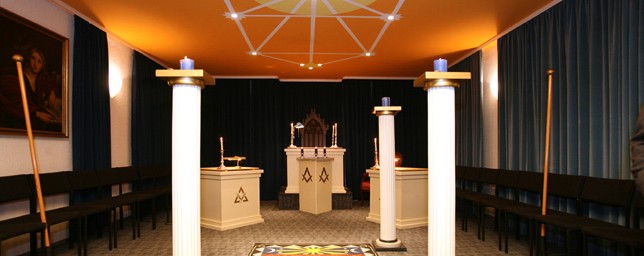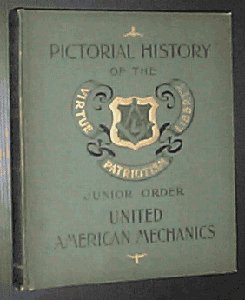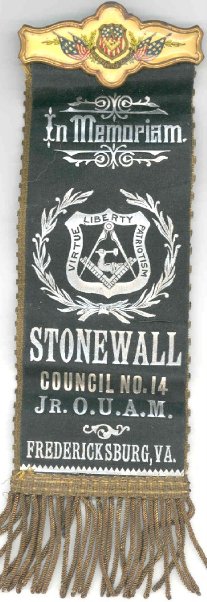En:Nativist Orders: Unterschied zwischen den Versionen
Keine Bearbeitungszusammenfassung |
|||
| Zeile 29: | Zeile 29: | ||
When the Tiffin, Ohio Junior Order Home took in more children than its capacity, the Juniors pondered the possibility of building a branch Home. The idea failed twice during the National Convention, once in 1903, and again in 1921. The National Convention was only held every two years, and the next time it met in 1923 the Tiffin Home had over 200 children more than its capacity. The North Carolina Juniors, having the highest Junior Order membership, were eager to have a branch Home in their state. They offered to fund this project considerably. It was decided that a branch Home would be built in Lexington, North Carolina. | When the Tiffin, Ohio Junior Order Home took in more children than its capacity, the Juniors pondered the possibility of building a branch Home. The idea failed twice during the National Convention, once in 1903, and again in 1921. The National Convention was only held every two years, and the next time it met in 1923 the Tiffin Home had over 200 children more than its capacity. The North Carolina Juniors, having the highest Junior Order membership, were eager to have a branch Home in their state. They offered to fund this project considerably. It was decided that a branch Home would be built in Lexington, North Carolina. | ||
[[Datei:Nativist3.jpg|thumb|300px|This book clearly describes the Jr. OUAM and their "No Immigrants Need Apply" policies. | |||
History of the Junior Order United American Mechanics | |||
Published - 1896 | |||
Part 1. Edited by Edward S. Deemer | |||
Part 2. By George A. Cleveland and Robert E. Campbell | |||
Published in Boston: The Fraternity Publishing Co. | |||
Printed by Norwood Press. Norwood, Mass. | |||
Pages: 114 + 97 + Plates. 12.00 inches x 10.50 inches | |||
This is the history of a secret American fraternal society which was created to assist native-born Americans in combating the "threat" of immigrants and foreigners in America. | |||
This fraternal group was founded in Germantown, near Philadelphia, in the mid 1800s. | |||
The fraternity had 2 goals: "restriction of immigration" and keeping the Bible in schools. There were 160,000 members throughout the U.S. | |||
Ironically enough, the fraternity's first leader was [[Daniel Pastorius]], a direct descendant of the German immigrant [[Francis Daniel Pastorius]], the founder of '''Germantown''', who is considered the Father of Germans in America. | |||
There are two 1896 books bound into one volume. Book One is a history of the fraternity, with details and statistics of the state-by-state organizations. | |||
Book Two is a collection of illustrations and descriptions of "our country's patriotic shrines." Included are: Plymouth Rock, Jamestown, Williamsburg, Roger Williams, Salem and Witchcraft, Colonial New Hampshire, Historic Homes of Philadelphia, Boston and Liberty, Richmond, Independence Hall, Lexington, Ticonderoga and Crown Point, Bunker Hill, Long Island, West Point, Valley Forge, Trenton - Princeton - Monmouth, Yorktown, Mount Vernon, Battle of Lake Erie, Andrew Jackson, Harrison and Tippecanoe, The White House, Ft. Sumter and Appomattox, Gettysburg, Arlington Heights, Abraham Lincoln, Ulysses S. Grant, etc. | |||
Both parts state the 1896 publication date. Book One has an 1896 copyright date. Book Two has no copyright date.]] | |||
The cornerstone laying ceremony was held on August 19, 1925. On March 1, 1928, the first 22 children (all from North Carolina) arrived. The Home in Lexington continued to grow. More buildings were constructed including the North Carolina Building, South Carolina Building, Pennsylvania Building, powerhouse, barns, superintendent’s residence, and the Sam F. Vance building (1932), which included a large auditorium, high school classrooms, vocational guidance rooms, home economics department, and a large modern gymnasium. | The cornerstone laying ceremony was held on August 19, 1925. On March 1, 1928, the first 22 children (all from North Carolina) arrived. The Home in Lexington continued to grow. More buildings were constructed including the North Carolina Building, South Carolina Building, Pennsylvania Building, powerhouse, barns, superintendent’s residence, and the Sam F. Vance building (1932), which included a large auditorium, high school classrooms, vocational guidance rooms, home economics department, and a large modern gymnasium. | ||
Version vom 16. Dezember 2010, 15:09 Uhr

OUAM
Courtesy of Phoenixmasonry
ORDER OF UNITED AMERICAN MECHANICS
JR. ORDER OF UNITED AMERICAN MECHANICS
JR. OUAM / DAUGHTERS OF AMERICA
The OUAM was founded in Philadelphia amidst the anti-alien riots of 1844-45. It originally was called the Union of Workers. It created an agenda specifically aimed at subverting immigrant prosperity in America. Members were required to undertake efforts to publicize and campaign against the hiring of cheap foreign labor. They were also to patronize only "American" businesses. It was essentially anti-immigrant and anti-Catholic.
In 1853 the Junior OUAM was founded. It achieved a peak membership of about 200,000 (1930-1937) compared to 40,000 for its parent organization.
The Junior Order United American Mechanics National Orphan’s Home, known as the Jr. Home, was significant in American history as an example of self-contained residential institutions that flourished in latter 19th and early 20th century America. The Jr. Home was a place “associated with events that have made a significant contribution to the broad patterns of America’s history.”
The Jr. Home was maintained by The Junior Order of United American Mechanics, an organization which began as the native American Association, a preeminently American society that had it’s origin in the anti-foreign movement of the late 18th and early 19th centuries. The Jr. Order of United American Mechanics was organized in May, 1853, in Philadelphia, PA, and quickly grew into a nationwide brotherhood inspired by the principles of Virtue, Liberty, Patriotism. With a total of 2,950 councils, the Jr. Order in 1930 was given the distinction of being called the leading Patriotic Order of the United States.
Jr. Home Orphanage
The Jr. Home Orphanage was established in 1896 and closed in 1944. The orphanage grew from a single farm residence into a self-supporting community, populated by as many as 1,200 residents during its peak years of the 1930-1937 area. As a self-sufficient community, the complex included a wide range of structures; residence cottages, a chapel, a gymnasium, grade and high schools, a vocational (trade) school, a hospital, a central dining hall, a bank and a post office, a nursery, a library, a laundry, a cannery, a power plant and an administrative building. All structures were brick with stone or concrete trim, except the cannery, which was stucco covered, the greenhouse, which was glass, and the chapel, which was constructed of gray limestone.
By 1930, all the major campus buildings had been erected, numbering approximately forty (40) buildings. The residential cottages were planned according to the three (3) distinct architectural designs over a period of thirty (30) years from 1897 – 1925. Each was sponsored by and named for various state councils of The Junior Order of United American Mechanics. The self-sufficiency aspect of the Junior Home is evident in the construction of the Kentucky Memorial Hospital in 1908. Until 1928, the Junior Home hospital was the only hospital in the area and was opened to serve the local citizens of Tiffin, Ohio and surrounding communities until 1915. The canning factory was constructed in 1913 to can the surplus fruits and vegetables from the ever-expanding farm. The cannery was valuable to the Home, both financially and educationally, as courses in food preservation were offered as part of the Junior Home Vocational program. In 1920, for example, the canning factory packed 995 cans of pears, 15,140 cans of corn, 2,673 cans of beans, as well as large quantities of tomatoes and kraut. Other vocational training consisted of home economics, auto mechanics, art fiber weaving, baking, cement construction, electrical work, farming, dairying, animal husbandry, greenhouse and garden, laundering, motion picture operation, painting, printing, plumbing, practical nursing, stationery secretary, engineering, shoe repair, woodworking, carpentry, newspaper work, proof reading, instrumental music, sewing, store clerking, and cooking.
[[Datei: ]]
]]
Tiffin Home
When the Tiffin, Ohio Junior Order Home took in more children than its capacity, the Juniors pondered the possibility of building a branch Home. The idea failed twice during the National Convention, once in 1903, and again in 1921. The National Convention was only held every two years, and the next time it met in 1923 the Tiffin Home had over 200 children more than its capacity. The North Carolina Juniors, having the highest Junior Order membership, were eager to have a branch Home in their state. They offered to fund this project considerably. It was decided that a branch Home would be built in Lexington, North Carolina.

The cornerstone laying ceremony was held on August 19, 1925. On March 1, 1928, the first 22 children (all from North Carolina) arrived. The Home in Lexington continued to grow. More buildings were constructed including the North Carolina Building, South Carolina Building, Pennsylvania Building, powerhouse, barns, superintendent’s residence, and the Sam F. Vance building (1932), which included a large auditorium, high school classrooms, vocational guidance rooms, home economics department, and a large modern gymnasium.
Lexington Home
Daily life at the Lexington Home was much like that of the Tiffin Home. There was the routine of breakfast, farm work and chores, dinner, homework, and bed. During the summer months the children enjoyed organized recreational activities such as tennis tournaments, basketball, and baseball. They also had a swimming pool donated in 1933 by the Orphan’s Home League of Louisville, KY.
Religious services were an important part of the childrens lives. Since the Home was in a rural location, worship services were held in the Home’s auditorium. The Junior Home Church had no denominational affiliations, but required the pastor to be a regularly ordained minister of an orthodox, Protestant denomination.
There was a general loss of membership in the Junior Order during the depression. Members who could not afford to pay their dues had little choice but to withdraw from the Junior Order. The Social Security Act of 1935 made it possible for mothers to support their children.
The National Council decided at their November 1939 meeting to revert to one Home – in Tiffin, Ohio. It was decided that the North Carolina Juniors would take the responsibility of keeping the Lexington Home open for North Carolina children only. Children in the Lexington Home who were from states other than North Carolina traveled by train to Tiffin, and on the return trip the Tiffin orphans from North Carolina were transferred to Lexington.
In 1944, the National Council announced that the Tiffin Home would be closed, and the remaining 100 children be sent to the Lexington Home. The Tiffin Home buildings would be leased to the State of Ohio for institutional use. The Lexington Home continued to operate on a largely self-sufficient basis during World War II.
Despite their declining membership, the Junior Order continued to promote the Home throughout the 1940’s and 1950’s. The admission requirements were relaxed in the 1940’s to include those whose mothers were deceased, but the father was still living, and children whose fathers were in the Armed forces. In the 1950’s, the Home admitted children whose uncle, grandfather, or cousin was a member of the Junior Order. In 1968, the Council amended its By-laws to allow the Council to provide financial support for the Home even if no children of Junior Order members resided there.
Financial difficulties continued to plaque the Home in the 1970’s. Even though the Board applied for financial assistance for eligible children through the Aid to Families with Dependent Children program and established an Emergency Repair Fund during the 1970’s, the North Carolina Junior Order raised money for and built a Memorial Chapel at the Home.
The Board of Trustees for the Home actively pursued certification by the Social Service Commission. The North Carolina Department of Human resources required that the Home and the state Junior Order be incorporated separately. The Social Service Commission licensed the Home as a child care institution in 1975. Because of the licensing, the criteria for child care changed greatly after 1975. In 1979, a financial development officer joined the staff of the Home. Today, restoration and renovation of the Home’s (now known as the American Children’s Home) buildings continues.
Information taken from the book The Home Down South: The Junior Order Children’s Home 1925-1985, Sam Leonard Beck, 1994
During its' (48) years of operation, The Junior Home had been “Home” to over 5,000 children from over twenty-eight states of these United States of America. It is obvious that with 850 acres and (50) buildings, The Jr. Home was, indeed, a unique experience in the annals of human endeavor. “We have written of events rather than of people, portraying what has been built, rather than the architect. Architects there have been – many of them – and they have built, not on the sands of the sea that are soon washed away, but upon the firm rock of human understanding, and that which they have built will long stand as monuments to their endeavors!”
Junior Home Alumni Association
The Junior Home Alumni Association still operates a website with the goal to keep "HomeKids" in touch with each other. A past alumni president Melanie Simons would love to hear from those inquiring about the history of the Jr. OUAM. Melanie can be contacted at:
By 1979, the Jr. OUAM had only about 8500 members. When the National Council Jr. OUAM made the decision to close the Lexington Home in 1939 - 40 the Junior Order members in the state of North Carolina called a special statewide meeting to discuss the closing. In a unanimous vote, the Junior Order members voted to take over the Home. The deed to the Home resides in the State Council Office on the campus of the Home. The North Carolina State Council of the Jr. OUAM is the owner of the Home. Since 1941 the North Carolina State Council of the Junior Order United American Mechanics has operated, and continues to this day, the Home (American Children's Home see their link at www.ach-nc.org ). Over time, the Jr. OUAM opened its membership to Jews, blacks, Catholics, and women. The lady’s order of the Jr. OUAM is the Daughters of America.
Concurrent with these organizations was the founding of a terrorist organization named the Know-Nothing Party. It also directed its energies against immigrants and may well have been connected with one or both organizations. It has also been charged that the Jr. OUAM had links to the KKK in the 1920’s. There can be little doubt that it once shared the same philosophy.
Jr. OUAM pieces are much more common than the OUAM pieces (upper left). The OUAM piece shown is cheap stamped tin plate with poor quality enamel. The OUAM was clearly a working class fraternity. The Jr. OUAM irritated the Masons with their use of the Square and Compass and it said the Masons hauled them into court to try to get them to stop using it. This was obviously not successful as they are still using it today.

